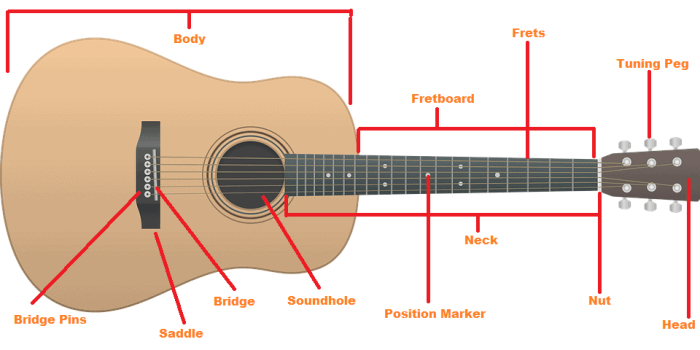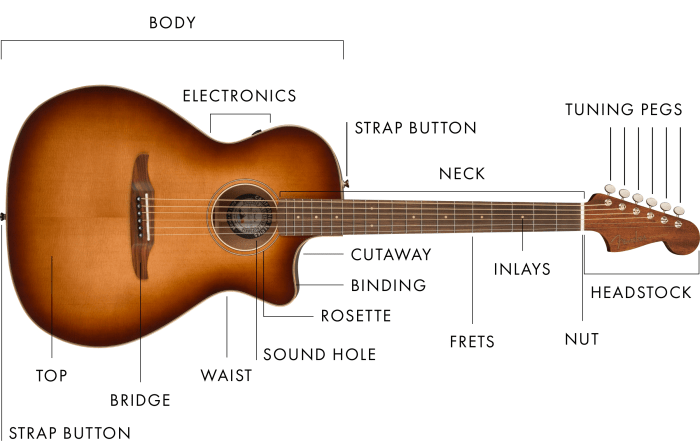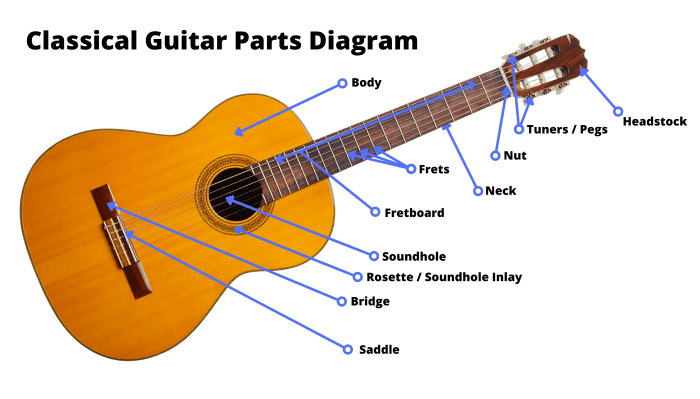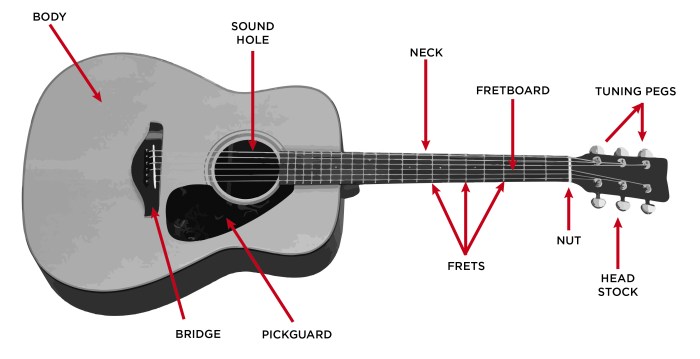Parts of an acoustic guitar diagram – Delving into the intricate world of acoustic guitars, this comprehensive guide presents a detailed diagram of its components, unveiling the secrets behind its captivating sound and playability.
From the resonant body to the intricate fretboard, each element of an acoustic guitar contributes to its unique character. This exploration unravels the materials, construction techniques, and functional significance of these components, empowering musicians with a profound understanding of their instrument.
Guitar Body
The guitar body is the main resonant chamber of the instrument and plays a crucial role in determining its overall sound. Different types of guitar bodies produce distinct tonal characteristics due to variations in their construction and materials.
Types of Guitar Bodies
- Solid Body:Solid-body guitars feature a solid piece of wood or other material for the body, providing a bright, articulate sound with excellent sustain. They are commonly used in electric guitars, as they minimize feedback and allow for a wide range of pickup configurations.
- Semi-Hollow Body:Semi-hollow guitars have a hollow chamber inside the body, usually with sound holes on the top. This combination of solid and hollow construction produces a warmer, more resonant sound with increased sustain compared to solid-body guitars.
- Hollow Body:Hollow-body guitars have a fully hollow body, resulting in a rich, mellow sound with excellent resonance and sustain. They are often used in jazz and blues music, providing a warm, organic tone.
Diagram of a Guitar Body
[Provide a diagram of a guitar body with labeled parts, such as top, back, sides, neck joint, etc.]
Materials Used in Guitar Body Construction
The materials used in guitar body construction have a significant impact on the instrument’s tone and weight.
- Wood:Wood is the most common material used for guitar bodies, with different species offering unique tonal characteristics. Mahogany provides a warm, resonant sound, while alder is known for its balanced tone. Rosewood and maple are often used for their bright, articulate sound.
- Metal:Metal bodies, typically made of aluminum or brass, produce a bright, aggressive sound with excellent sustain. They are commonly used in electric guitars, especially those designed for heavy music genres.
- Plastic:Plastic bodies are lightweight and durable, offering a variety of tonal options depending on the specific material used. They are often found in budget-friendly guitars and electric guitars designed for specific genres.
Neck

The neck of an acoustic guitar is a long, thin piece of wood that connects the body to the headstock. It provides a surface for the strings to vibrate and is responsible for the guitar’s overall playability and tone.
There are three main types of guitar necks: bolt-on, set-neck, and neck-through.
Bolt-On Necks
Bolt-on necks are attached to the body with screws or bolts. This type of neck is relatively easy to remove and replace, making it a good option for guitars that may need frequent repairs or modifications.
Advantages:
- Easy to remove and replace
- Relatively inexpensive to produce
Disadvantages:
- Can be less stable than other types of necks
- May produce a slightly different tone than other types of necks
Set-Necks
Set-necks are glued into the body of the guitar. This type of neck provides a more stable and resonant connection between the neck and body, which can result in a better tone and sustain.
Advantages:
- More stable than bolt-on necks
- Can produce a better tone and sustain
Disadvantages:
- More difficult to remove and replace
- More expensive to produce
Neck-Through Necks
Neck-through necks are a single piece of wood that runs the entire length of the guitar, from the headstock to the body. This type of neck provides the best possible stability and resonance, but it is also the most expensive and difficult to produce.
Advantages:
- Best possible stability and resonance
- Can produce a very consistent tone across the entire fretboard
Disadvantages:
- Most expensive and difficult to produce
- Can be difficult to repair if damaged
In addition to the type of neck, the shape of the neck can also affect the playability and tone of the guitar. The most common neck shapes are C-shaped, V-shaped, and U-shaped. C-shaped necks are the most common and are considered to be the most comfortable to play.
V-shaped necks are thinner and faster, which can make them easier to play for some players. U-shaped necks are thicker and rounder, which can provide more support for the hand.
The neck of the guitar is a complex and important part of the instrument. The type of neck, the shape of the neck, and the materials used to construct the neck can all affect the playability, tone, and overall quality of the guitar.
Diagram of a Guitar Neck
[Image of a guitar neck with labeled parts]
Parts of the Guitar Neck
- Headstock
- Fretboard
- Truss rod
- Nut
- Tuners
Truss Rod
The truss rod is a metal rod that runs inside the neck of the guitar. It is used to adjust the curvature of the neck, which can affect the playability and intonation of the guitar. When the truss rod is tightened, the neck will bow forward, which will raise the strings and make them easier to play.
When the truss rod is loosened, the neck will bow backward, which will lower the strings and make them harder to play.
It is important to adjust the truss rod correctly, as too much or too little tension can damage the neck. If you are not sure how to adjust the truss rod, it is best to take your guitar to a qualified guitar technician.
Fretboard
The fretboard is the long, narrow strip of wood that runs down the center of the guitar’s neck. It is made of a variety of materials, including rosewood, maple, and ebony. The type of wood used for the fretboard can affect the playability and tone of the guitar.
For example, rosewood is known for its warm, rich sound, while maple is known for its bright, clear sound. The fretboard is divided into frets, which are thin metal strips that run perpendicular to the strings. The frets divide the fretboard into different pitches, and the distance between the frets determines the scale length of the guitar.
The scale length is the distance between the nut and the bridge, and it affects the tension of the strings and the overall sound of the guitar. The fretboard also has a number of inlays, which are small pieces of wood or plastic that are used to mark the different positions on the fretboard.
The most common type of inlay is the dot inlay, but there are also a variety of other types of inlays, such as diamond inlays, square inlays, and triangle inlays. The nut is a small piece of bone or plastic that is located at the top of the fretboard.
The nut holds the strings in place and determines the height of the strings above the fretboard. The height of the strings is important because it affects the playability and tone of the guitar. Fret leveling and intonation are two important aspects of guitar maintenance.
Fret leveling is the process of leveling the frets so that they are all the same height. This is important because it ensures that the strings are all the same distance from the fretboard, which makes it easier to play the guitar.
Intonation is the process of adjusting the length of the strings so that they are all in tune with each other. This is important because it ensures that the guitar sounds good when it is played.
Headstock: Parts Of An Acoustic Guitar Diagram
The headstock is the part of the guitar that extends from the end of the neck and contains the tuners. It serves several functions, including providing a place to attach the strings, housing the tuning pegs, and contributing to the guitar’s overall balance and appearance.There
are several different types of headstocks, each with its own unique aesthetic and functional implications. Some of the most common types include:
- Symmetrical headstocksare the most common type and feature a symmetrical shape with the tuners arranged in a straight line. This type of headstock provides a balanced look and feel and is often found on classical and folk guitars.
- Asymmetrical headstocksare less common and feature an asymmetrical shape with the tuners arranged in a staggered pattern. This type of headstock can provide a more aggressive or modern look and is often found on electric guitars.
- Reverse headstocksare a unique type of headstock in which the tuners are reversed, with the low E string tuner located at the top of the headstock and the high E string tuner located at the bottom. This type of headstock can provide a more balanced feel and is often found on headless guitars.
In addition to the tuners, the headstock also typically features a string tree, which is a small piece of metal or plastic that helps to keep the strings in place. The headstock may also feature a logo or other decorative elements.The
nut is a small piece of material that is located at the end of the headstock and serves to secure the strings and adjust their height. The nut is typically made of bone, plastic, or graphite and is slotted to accommodate the strings.
The height of the nut can be adjusted to ensure that the strings are at the correct height for playing.
Bridge

The bridge of an acoustic guitar is a crucial component that supports the strings, transfers their vibrations to the body, and allows for precise intonation adjustment. Different types of bridges have varying impacts on tuning stability and sustain.
Types of Guitar Bridges
Fixed Bridge: A fixed bridge is permanently attached to the guitar body and provides excellent tuning stability. It is commonly found on classical and traditional acoustic guitars.Floating Bridge: A floating bridge is not directly attached to the guitar body and can move slightly.
This allows for greater vibrato effects but may compromise tuning stability. It is often used on electric guitars and some modern acoustic guitars.Tremolo Bridge: A tremolo bridge is a type of floating bridge that allows for controlled pitch changes by moving the bridge back and forth with a tremolo bar.
It provides a wide range of expressive possibilities but requires careful setup and maintenance to maintain tuning stability.
Diagram of a Guitar Bridge
[Insert diagram of a guitar bridge]
Parts of a Guitar Bridge:* Saddles: Individual metal pieces that support the strings and allow for intonation adjustment.
Intonation Screws
Screws used to adjust the string length and ensure accurate intonation.
Pickup Selector Switch (optional)
A switch that allows the player to select different pickup configurations on guitars with multiple pickups.
Importance of Bridge Height Adjustment
The height of the bridge can significantly affect the playability and tone of the guitar. A properly adjusted bridge height ensures:* Comfortable playing action: The strings are at an optimal height for easy fretting.
Improved intonation
The strings are in tune at all frets.
Balanced tone
The bridge height affects the transfer of string vibrations to the body, influencing the overall sound quality.
Pickups

Guitar pickups are electromagnetic transducers that convert the vibrations of the guitar strings into electrical signals. These signals are then amplified and sent to the guitar’s output jack, where they can be connected to an amplifier or recording device.
There are three main types of guitar pickups: single-coil, humbucker, and P-90. Single-coil pickups are the most common type, and they produce a bright, twangy sound. Humbucker pickups are made up of two single-coil pickups that are wired together in opposite phase, which cancels out the hum that is common in single-coil pickups.
P-90 pickups are a type of single-coil pickup that is wider and has a thicker sound than a standard single-coil pickup.
Diagram of a Guitar Pickup
The diagram below shows the parts of a guitar pickup. The coils are made of copper wire, and they are wrapped around a magnet. The pole pieces are made of metal, and they are located under the coils. When the strings vibrate, they create a magnetic field that interacts with the magnetic field of the pickup.
This interaction creates an electrical signal in the coils, which is then sent to the guitar’s output jack.
- Coils
- Magnet
- Pole pieces
Pickup Placement
The placement of the pickups on the guitar’s body has a significant impact on the guitar’s overall tone. Pickups that are placed closer to the bridge will produce a brighter sound, while pickups that are placed closer to the neck will produce a warmer sound.
The distance between the pickups and the strings also affects the tone of the guitar. Pickups that are closer to the strings will produce a louder sound with more sustain, while pickups that are further away from the strings will produce a quieter sound with less sustain.
Electronics

Guitar electronics play a vital role in shaping the tone and sound of an electric guitar. They consist of various components such as potentiometers, capacitors, and resistors, each contributing to the overall sonic character of the instrument.
A typical guitar electronics system comprises the following parts:
Volume Knob
The volume knob controls the output level of the guitar, allowing the player to adjust the volume from soft to loud.
Tone Knob, Parts of an acoustic guitar diagram
The tone knob filters out certain frequencies, altering the tonal characteristics of the guitar. It can be used to brighten or darken the sound.
Pickup Selector Switch
The pickup selector switch allows the player to choose between different pickup configurations, each with its unique tonal qualities.
Soldering and Wiring
Soldering and wiring are essential techniques in guitar electronics. Soldering involves joining two metal surfaces using a metal alloy, while wiring connects the various components of the electronics system. Proper soldering and wiring techniques ensure reliable electrical connections and minimize noise.
Q&A
What are the different types of guitar bodies?
Guitar bodies come in various forms, including solid, semi-hollow, and hollow, each imparting distinct tonal qualities and resonance characteristics.
What is the role of the truss rod?
The truss rod is a crucial component that allows for adjusting the neck’s curvature, ensuring optimal playability and intonation.
What are the advantages of different pickup types?
Single-coil pickups offer a bright and twangy sound, while humbuckers provide a warmer and more powerful tone. P-90 pickups combine elements of both, delivering a versatile and punchy sound.